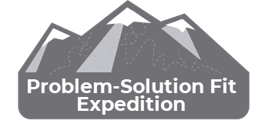Problem-Solution fit expedition
The purpose of this expedition is to rapidly transform the promising business concepts into viable innovation initiatives that can be taken forward by the organization to address its strategic problem/challenge and fulfill its related aspirations.
The viable concepts, validated in terms of desirability, feasibility, defensibility and impact to certain extent, are then developed and deployed iteratively to potential early adopters in the next expedition: the Solution-Market fit expedition.
Description
A common pattern in this expedition is that an innovation team takes the selected promising concepts, identify the key assumptions underlying them and test them by taking low-fidelity rapid prototypes into the real world.
A team does this by conducting small and inexpensive experiments that allow them to learn what works and what doesn´t in the most timely, least costly and fastest way possible. The team can then use the new knowledge to refine prototypes and continue learning until it is proven that the concept is viable (or not) in the way it is fundamentally designed.
By failing and learning fast (and cheap), an innovation team is able to make progress nimbly and present the outcomes to key stakeholders (e.g. business owners, an innovation council, potential investors, etc.) at a cadence-based review event or by request when an important milestone is achieved and further investment or support is required.
Toolkits (“Exploration Backpacks”)
The team can accomplish outcomes by selecting activities and tools for the purpose, especially from the “experiment” backpack such as storyboard, paper prototyping, wireframe, digital mockup, pitch deck, video prototyping, and functional “to be thrown away” prototyping techniques (e.g. “Concierge” and “Wizard of Oz” MVPs).
These tools enable a team to rapidly and inexpensively build and test different types of assumptions related to parts of the solution concept or the whole solution concept, so that the team learns and decides whether to adjust, pivot or shelf the concept or validate its viability with a certain level of confidence. The latter marks the key broad milestone for this expedition, identified in the model as “business viability”.


